
Freebird Sailing the Globe
14 September 2013 | Exuma, Bahamas
08 August 2013 | Georgetown, Great Exuma, Bahamas
07 July 2013 | Crackerboy Boat Works, Riviera Beach, FL
01 January 2013 | Mayaguana Passage
06 December 2012 | Cape Verdes - Caribbean
06 November 2012 | Cape Verdes
12 October 2012 | La Graciosa
14 September 2012 | Rabat & Casablanca
28 August 2012
06 August 2012 | 36 09.38N
20 July 2012 | Spain
15 June 2012 | San Antioco Is/San Pietro Is
30 May 2012 | Tunisia
13 May 2012 | Marain di Ragusa, Sicily
10 March 2012 | San Marco Square, Venice
10 March 2012 | Marina di Ragusa, Sicily, Italy
09 March 2012 | Marina di Ragusa, Sicily, Italy
NEW RIG
14 September 2013 | Exuma, Bahamas
Freebird Sailing Adventures
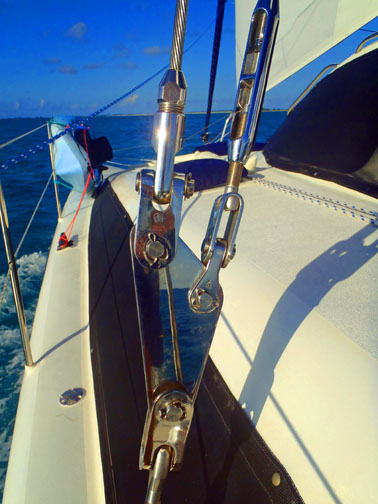
What changes do you make to standing rigging after suffering a dismasting at sea...at night? It happened to us 6 months ago in the southern Bahamas. Such a terrifying experience made us sink our teeth into installing a beefier rig.
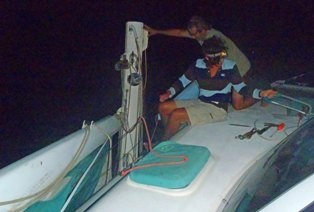
(DISASTER Blog posted: 01/01/2013)
Mack Sails (with SELDEN Rigging) designed the standing and running rigging. The mast was stepped at Crackerboy Boat Works (Publix grocery and West Marine were just down the quiet street!). We were allowed to live aboard and do our own work.
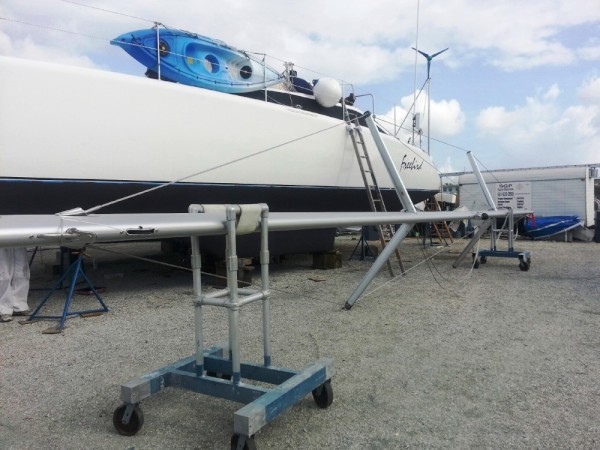
Crackerboy Boat Works
A new crossbeam, over-sized toggles and chainplates completed the kit.
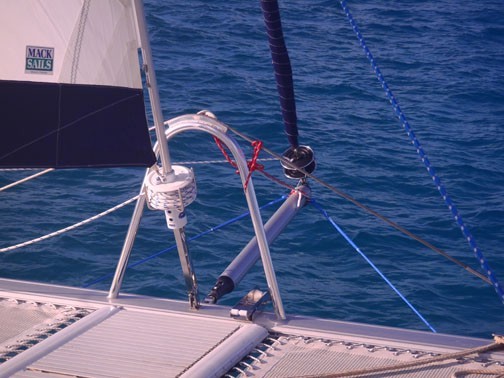
New Crossbeam by SELDEN
Once the mast was stepped, new sails arrived: roller furling screecher, main and roller furling genoa.
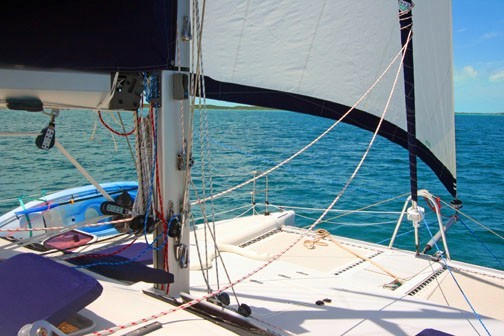
New Screecher and Genoa
We were then ready to return to paradise in the Exuma, Bahamas!
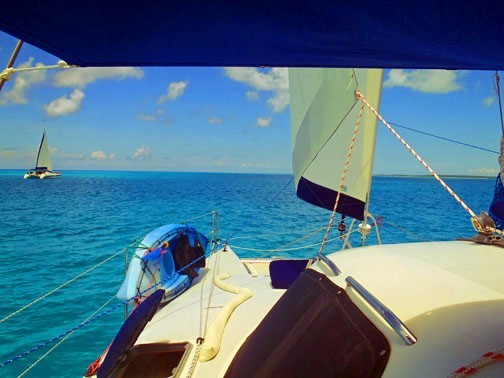
New Helm Awnings

(DISASTER Blog posted: 01/01/2013)
Mack Sails (with SELDEN Rigging) designed the standing and running rigging. The mast was stepped at Crackerboy Boat Works (Publix grocery and West Marine were just down the quiet street!). We were allowed to live aboard and do our own work.

Crackerboy Boat Works
A new crossbeam, over-sized toggles and chainplates completed the kit.

New Crossbeam by SELDEN
Once the mast was stepped, new sails arrived: roller furling screecher, main and roller furling genoa.

New Screecher and Genoa
We were then ready to return to paradise in the Exuma, Bahamas!

New Helm Awnings
Return to Paradise
08 August 2013 | Georgetown, Great Exuma, Bahamas
Freebird Sailing Adventures
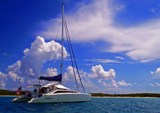
A new season of chartering begins in our island paradise: the Exumas, located in the central Bahamas.
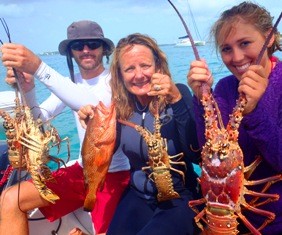
We offer family and group charters for the budget minded. To entertain our guests, we teach visitors how to navigate blue-water, free-dive for the fresh catch of the day, and sail. At night, our travel adventures gathered from around the world will captivate you.
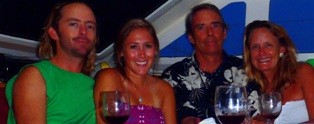
Mind you, this unique experience is addictive for the adventurous minded. Many return land-side to sell everything and head back to the sea in a boat, and never look back.
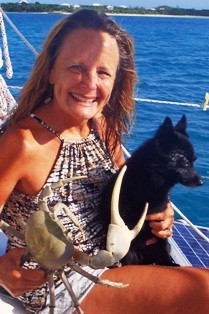

We offer family and group charters for the budget minded. To entertain our guests, we teach visitors how to navigate blue-water, free-dive for the fresh catch of the day, and sail. At night, our travel adventures gathered from around the world will captivate you.

Mind you, this unique experience is addictive for the adventurous minded. Many return land-side to sell everything and head back to the sea in a boat, and never look back.

Haul Out
07 July 2013 | Crackerboy Boat Works, Riviera Beach, FL
Freebird Sailing Adventures
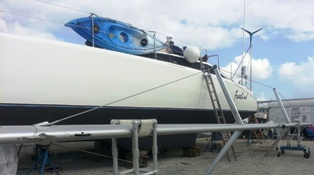
In the wake of our December dismasting, we motored to the mooring field of Dinner Key Mooring Facility in Miami to complete the arduous process of filing an insurance claim to cover the loss of rig and sails. The claim was settled within 4 months. We then made our way to Crackerboy in Riviera Beach to step the mast and fit sails from Mack Sails. The bottom was painted and all new interior decor completed with my trusty sewing machine.
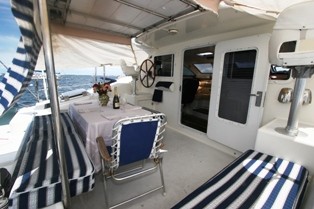
Freebird was finally ready to return to the delightful island chain of the Exumas, Bahamas to commence chartering. The kitty needed beefing up a bit too, so what better than to share the cruising life with adventurous souls while loving it to increase the cash flow?
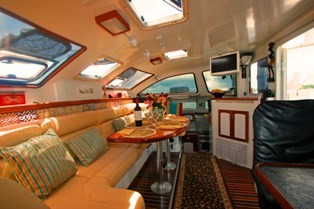

Freebird was finally ready to return to the delightful island chain of the Exumas, Bahamas to commence chartering. The kitty needed beefing up a bit too, so what better than to share the cruising life with adventurous souls while loving it to increase the cash flow?

DISMASTING in the Bahamas
01 January 2013 | Mayaguana Passage
Freebird Sailing Adventures
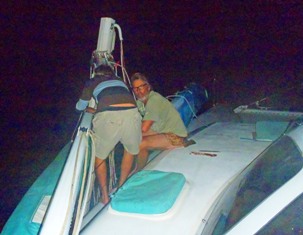
A loud crash and a splash announced we had been abruptly dismasted. It was 8:30pm, December 18, 2012. Why do bad things happen at night?
We had been on a close reach under light winds in the Mayaguana Passage, located in the southern Bahamas between the Plana Cays and Mayaguana. The mainsail and genoa had been up and full. We were clipping along on a nicely on a moonless night. Sailing under 10knots of easterlies, we were unprepared for what was soon to be our worst nightmare.
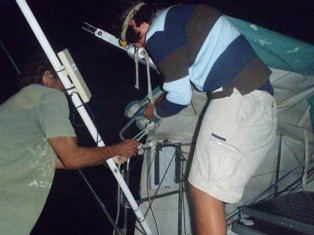
Onboard were Pete, myself, and my nephew Ian. Ian had boarded Freebird in the Cape Verde Islands (located off the nw African coast) as crew for the ocean crossing. Our transatlantic crossing had taken 16 days. Other than a few days in the doldrums, it had been an uneventful passage though fraught with lumpy, confused seas and squalls.
We knew the tradewinds had not fully set in upon our departure from the south Atlantic islands of the Cape Verdes, but Christmas was upon us. The kids were waiting for us in the Bahamas. With jerry cans of fuel, we took off on a favorable forecast with a fleet of sailboats en route to the Caribbean. Many were friends, cultivated over a summer of cruising the Mediterranean, Morocco and the Atlantic Islands. A daily net kept us all in communication in case anyone needed help, a true sense of comfort. It was not there for us on the night of our disaster.
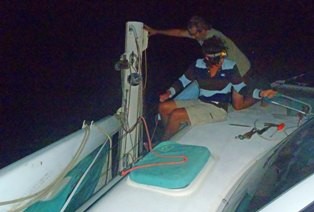
Once the mast, 2 Pro-furls, bowsprit, genoa, screecher, mainsail and boom fell into the sea, it took 2 hours to cut the rig from Freebird. When the mast had fallen, the boom had crashed into the port captain's steering station. This was the first night after a month of sailing that Ian was not in that helm seat. He had chosen to take watch in the starboard captain's chair. I shudder to consider the consequences, otherwise.
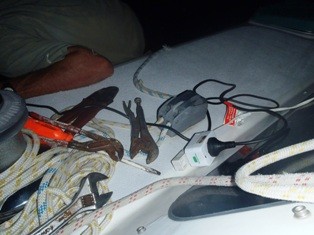
We worked feverishly, knowing it was only a matter of time the floundering spreaders damaged our port hull. An electric saw (THANK YOU DAVE FOR LEAVING IT ONBOARD after selling us the boat!), scissors, handsaws, and pliers were our surgical tools.
Once the rig was free, it quickly sank to the bottom of the sea, no longer a navigation hazard. We powered up both engines and limped to Georgetown in time to meet our sons for holiday reverie.
The culprit? A failed starboard toggle.
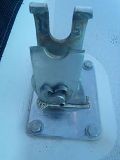
Thank goodness we had a reputable insurance company standing by to begin the arduous process of handling our claim.
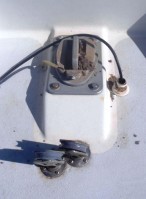
We'll be back to the Bahamas, hopefully in time for the summer. Surely, in time for the autumn.
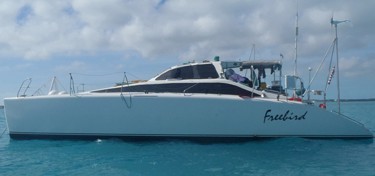
It takes more than a dismasting to dislodge us from our Freebird.
We had been on a close reach under light winds in the Mayaguana Passage, located in the southern Bahamas between the Plana Cays and Mayaguana. The mainsail and genoa had been up and full. We were clipping along on a nicely on a moonless night. Sailing under 10knots of easterlies, we were unprepared for what was soon to be our worst nightmare.

Onboard were Pete, myself, and my nephew Ian. Ian had boarded Freebird in the Cape Verde Islands (located off the nw African coast) as crew for the ocean crossing. Our transatlantic crossing had taken 16 days. Other than a few days in the doldrums, it had been an uneventful passage though fraught with lumpy, confused seas and squalls.
We knew the tradewinds had not fully set in upon our departure from the south Atlantic islands of the Cape Verdes, but Christmas was upon us. The kids were waiting for us in the Bahamas. With jerry cans of fuel, we took off on a favorable forecast with a fleet of sailboats en route to the Caribbean. Many were friends, cultivated over a summer of cruising the Mediterranean, Morocco and the Atlantic Islands. A daily net kept us all in communication in case anyone needed help, a true sense of comfort. It was not there for us on the night of our disaster.

Once the mast, 2 Pro-furls, bowsprit, genoa, screecher, mainsail and boom fell into the sea, it took 2 hours to cut the rig from Freebird. When the mast had fallen, the boom had crashed into the port captain's steering station. This was the first night after a month of sailing that Ian was not in that helm seat. He had chosen to take watch in the starboard captain's chair. I shudder to consider the consequences, otherwise.

We worked feverishly, knowing it was only a matter of time the floundering spreaders damaged our port hull. An electric saw (THANK YOU DAVE FOR LEAVING IT ONBOARD after selling us the boat!), scissors, handsaws, and pliers were our surgical tools.
Once the rig was free, it quickly sank to the bottom of the sea, no longer a navigation hazard. We powered up both engines and limped to Georgetown in time to meet our sons for holiday reverie.
The culprit? A failed starboard toggle.

Thank goodness we had a reputable insurance company standing by to begin the arduous process of handling our claim.

We'll be back to the Bahamas, hopefully in time for the summer. Surely, in time for the autumn.

It takes more than a dismasting to dislodge us from our Freebird.
Transatlantic Crossing
06 December 2012 | Cape Verdes - Caribbean
Freebird
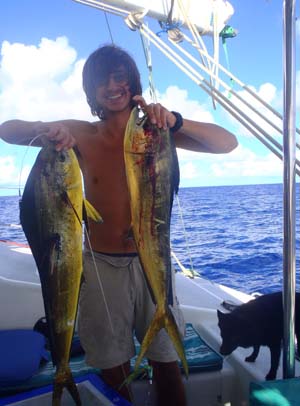
We departed with a great send-off of all our friends whom blared air horns in unison to announce our exit from the Mindelo anchorage. It was mid-morning: Sunday, November 18, 2012, day 1 of our transatlantic crossing. Ahead of us lay 2,188 nautical miles of blue water sailing. We were sailing from the Cape Verdes to the French Islands of the Caribbean. From there, we planned to buy needed boat gear at the discount marine store in St Martin. (They sell the best dinghies at the best prices in the world.) From there, we'd sail on to the Bahamas - our homebase for cruising and chartering after years of global cruising.
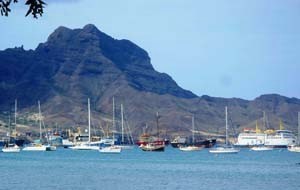
Onboard was my nephew Ian who had flown in from Spain after a summer of adventurous backpacking. At twenty-two years of age, Ian had never stepped aboard a cruising yacht, though he held great promise in problem solving and troubleshooting mechanical systems. He described himself as a night owl, an excellent character feature for standing tedious night watches. Ah, the young.
We departed under 15-18 knots of north-easterlies, running under main and jenny. Though these winds were too light for the heavier monohulls of our friends back in the Mindelo anchorage, we found them comfortable for use with our furling screecher and lightweight spinnaker. Our monohull friends were waiting for the Christmas Winds: very fresh, 25-30 knots of wind. They form from squeezed isobars that normally occur in late December and January. Being a performance catamaran, we preferred the lighter tradewinds in the 12-18 knot range, as Freebird sails at 80% of wind velocity, if on a broad reach. Give me comfort any day over rapid speed and stress.
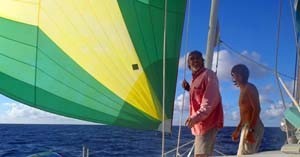
Right away we started landing mahi-mahi with our yoyo, a native fisherman's tool - sans rod - to catch fish. Basically, it's a plastic doughnut with 200 lb. test monofilament wrapped around it, found at most marine or tackle shops. Years ago, our expensive rods exploded from having snagged big fish, so we replaced them with the tough, cheap yoyos.
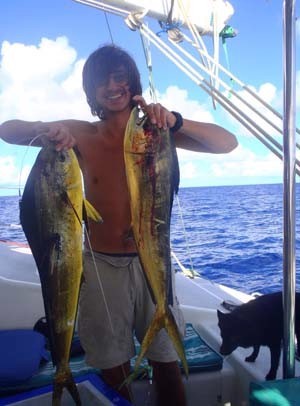
We were transiting the ocean with 8 other yachts. A twice daily marine net via SSB was followed, which gave our position and weather conditions. In time, more yachts joined the Net as they began the crossing. The Net became a humorous source of entertainment. It can be lonely out there on the high seas, so it was a welcome addition to our day.
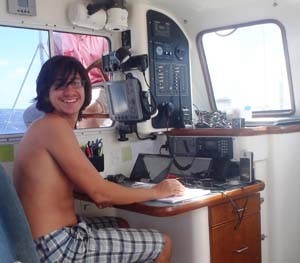
For the next couple of days, winds lessened into 10-12 knot north-easterlies. We alternated using our screecher at night and spinnaker during the day, as Ian was still learning the sails. Until he could drive the spinnaker with confidence, we minimize his effort at night with just using the screecher. Roll it in or out to reef - piece of cake. The dolphins came to tease Bella, our canine Schipperke.
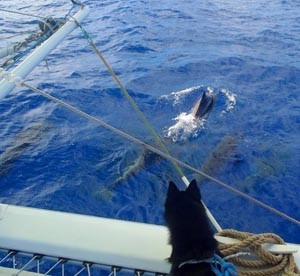
We celebrated Thanksgiving Day with a true feast sans turkey. It was our 4th day at sea. Soon, conditions worsened with two contrary swells that collided beneath our twin hulls, wreaking havoc with Freebird. Everyone on the Net complained about the cross-swell. We did nothing but hang on, eat, sleep, take watch.
After several days of the gnarly currents and cross-swell, Pete queried Herb Hinderberg of Southbound II about it. Herb is a passagemaker's dream come true, broadcasting sailing routes and forecasts from Canada based on our current weather conditions. He's been working with us for the last three decades when we're in his hemisphere. That night Herb exclaimed, "I can't make heads or tails of your currents. They're all over the place." It was our 6th day out. "But you have high winds coming in two days. Best to sail south of the region."
We took his recommended detour, sailing 50 degrees south. It gave us a slower pace, which allowed the increasing low pressure ahead of us time to diminish. Lost in the wind currents, a finch landed in our cockpit and chose Peter as its mother-of-the-day. It never flew away and we were able to deliver it to the Caribbean safely.
But it never did diminish. Instead it increased, swelling into a mini-storm: a very dangerous low pressure. It sat just north of the Virgin Islands, never really going anywhere and intensifying. The yachts transiting from the New England coast got caught in its fury as they began to enter the region. We could hear their woes of frustration when they checked into Herb's daily forecast.
We were now at our halfway mark of our pond crossing: only 1082 nautical miles to go. Confused seas seemed to have been with us the entire way by now. When the bumpy seas hit us on the beam, it tossed the wind from the sails. When it receded into the vast emptiness of the sea, the wind filled our sails again and off we went like a train. Down below, even though I couldn't see the sails, I cringed at the crescendo of cracking and creaking that wreaked havoc with our rigging from the confused seas. Ouch.
Squally weather arrived, remnants from the low pressure. For two days and nights, we endured gusty winds and rain. Bruised skies filled the horizon. It was smooth sailing between the squalls, but once under their edges of purple, all hell broke loose. If the helmsman wasn't sharp, it was arduous work reefing in the jenny.
Our crew member grew lax - a flaw of any inexperienced sailor. Not understanding the serious need to reef early, he failed to wake Peter in time to prepare for squalls. Peter grew fitful, unable to fully relax off-watch at night knowing a Chinese fire drill could erupt at anytime. And they did: over and over again.
After the repeated squalls, we had the hallowed eyed look of walking refugees. Friends behind us relished the stormy weather. "It's the only time we get wind," said a Hawaiian sailor with a family onboard. On the morning Net, he reported they had entered the doldrums (an area of no wind for miles all around) that was punctuated by the occasional squall.
Then it was our turn to experience the doldrums. The low pressure which had initially brought our squally weather had moved off towards the Azores, intensifying into a mini-storm. As it moved away, it sucked out all the wind in our region, creating a high pressure. For the first time forecasters can ever recall, the Caribbean was experiencing zero wind over the entire region. It was ALWAYS windy there.
And so we sat beneath the high pressure. And sat. It seemed like the Mediterranean all over again: either too much wind or none at all. Here we go. Sailors on the Net called it 'The Hole'. Being a performance catamaran, we were able to drift along at 75% of the velocity of wind on a broad reach or run. So under 3 knots of wind at our back, we glided along at 1.5 knots of speed under spinnaker.
Ian grew agitated with our slow drift across the vast ocean. "Turn on the engines. Let's get going," he wailed. It was not to be. We Dreffins' are hardly purest sailors, but we do honor the wind. When it blows, we sail; when it dies, we drift . . . for days, if need be. It drove my busy nephew crazy, same as when our two sons were once onboard. All around the world recently, they raved at their Dad for not revving up the engines on our St Francis 44' catamaran dubbed "Scud" (meaning, 'to move fast').
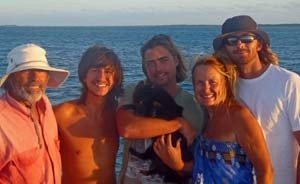
I smiled, laughing inside at the memories. Kids today are accustomed to iPods, iPads, iPhones, TV, video games, and constant texting. Twenty-two year-old Ian was immersed in the bootcamp of doldrum living at sea. In the end, he survived and did well. Never once did he loose his cool, as our sons often did. Ian held his tongue out of respect, even while steaming inside. To achieve inner calm, he threw himself into more book reading. Excellent choice, my lad -books lend insight greater than endless electronic chatter.
In times of no wind when we sailed with our teenaged sons around the world, Warren would leap into the sea from the bows, drift beneath the underside of "Scud", then scamper up the sugarscoops. This scared the crap out of me, but I'd never been able to control the reckless lad since he turned ten. His father merely smiled upon his wild antics. What was I to do?
I decided not to share this yarn with my nephew, whom revered his cousin. I didn't want to see our crewmember leaping into the sea. It'd be just my luck a rogue shark would lurk out of the deep to devour his skinny body, a tanned figure that resembled a turtle from beneath the waters.
It was day 15, past 2 weeks now. Our last two transatlantic crossings had ended after 14 days. As our 3rd crossing of the 'pond', this would be our longest record yet for these waters.
Our last day at sea - day 17 - the doldrums eased, supplanted by 18-22 knots of easterlies. We roared past Antigua at night, approached St Barts, and left Nevis to port. Freebird roared along under triple reefed jib, scudding along at 10 knots. The confused cross-swells were still with us. Darn those buggars. It was terribly exciting, but a little scary to rip along so fast after meandering along like a snail in the doldrums in the mid-Atlantic.
Our landfall was eventful at midnight, as we meandered our way through a moving fleet of three cruise ships exiting the docks in Dutch St Maarten. They were lit up like Christmas trees, a juxtaposition of holiday and Bob Marley tunes blaring for the tourists onboard with deck wide flatscreen video screens reflecting back the dancing revelers on the top deck.
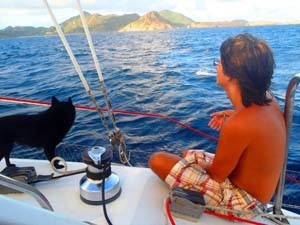
Against the backdrop of ambient light, we made way into the inner harbor, now in silhouette, to anchor next to the cruising fleet. It was December 5th: 17 days at sea. We hugged and shook hands in celebratory cheer, more than ready for our deep REM stage of sleep.
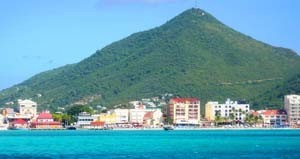
Later we sailed on to French St Martin for boat gear, on to St Thomas and Puerto Rico. Finally, on to the Bahamas where disaster hit barely 150nm from our final destination of our transatlantic crossing. (See the link in our blog.)
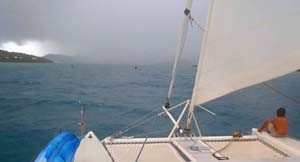

Onboard was my nephew Ian who had flown in from Spain after a summer of adventurous backpacking. At twenty-two years of age, Ian had never stepped aboard a cruising yacht, though he held great promise in problem solving and troubleshooting mechanical systems. He described himself as a night owl, an excellent character feature for standing tedious night watches. Ah, the young.
We departed under 15-18 knots of north-easterlies, running under main and jenny. Though these winds were too light for the heavier monohulls of our friends back in the Mindelo anchorage, we found them comfortable for use with our furling screecher and lightweight spinnaker. Our monohull friends were waiting for the Christmas Winds: very fresh, 25-30 knots of wind. They form from squeezed isobars that normally occur in late December and January. Being a performance catamaran, we preferred the lighter tradewinds in the 12-18 knot range, as Freebird sails at 80% of wind velocity, if on a broad reach. Give me comfort any day over rapid speed and stress.

Right away we started landing mahi-mahi with our yoyo, a native fisherman's tool - sans rod - to catch fish. Basically, it's a plastic doughnut with 200 lb. test monofilament wrapped around it, found at most marine or tackle shops. Years ago, our expensive rods exploded from having snagged big fish, so we replaced them with the tough, cheap yoyos.

We were transiting the ocean with 8 other yachts. A twice daily marine net via SSB was followed, which gave our position and weather conditions. In time, more yachts joined the Net as they began the crossing. The Net became a humorous source of entertainment. It can be lonely out there on the high seas, so it was a welcome addition to our day.

For the next couple of days, winds lessened into 10-12 knot north-easterlies. We alternated using our screecher at night and spinnaker during the day, as Ian was still learning the sails. Until he could drive the spinnaker with confidence, we minimize his effort at night with just using the screecher. Roll it in or out to reef - piece of cake. The dolphins came to tease Bella, our canine Schipperke.

We celebrated Thanksgiving Day with a true feast sans turkey. It was our 4th day at sea. Soon, conditions worsened with two contrary swells that collided beneath our twin hulls, wreaking havoc with Freebird. Everyone on the Net complained about the cross-swell. We did nothing but hang on, eat, sleep, take watch.
After several days of the gnarly currents and cross-swell, Pete queried Herb Hinderberg of Southbound II about it. Herb is a passagemaker's dream come true, broadcasting sailing routes and forecasts from Canada based on our current weather conditions. He's been working with us for the last three decades when we're in his hemisphere. That night Herb exclaimed, "I can't make heads or tails of your currents. They're all over the place." It was our 6th day out. "But you have high winds coming in two days. Best to sail south of the region."
We took his recommended detour, sailing 50 degrees south. It gave us a slower pace, which allowed the increasing low pressure ahead of us time to diminish. Lost in the wind currents, a finch landed in our cockpit and chose Peter as its mother-of-the-day. It never flew away and we were able to deliver it to the Caribbean safely.
But it never did diminish. Instead it increased, swelling into a mini-storm: a very dangerous low pressure. It sat just north of the Virgin Islands, never really going anywhere and intensifying. The yachts transiting from the New England coast got caught in its fury as they began to enter the region. We could hear their woes of frustration when they checked into Herb's daily forecast.
We were now at our halfway mark of our pond crossing: only 1082 nautical miles to go. Confused seas seemed to have been with us the entire way by now. When the bumpy seas hit us on the beam, it tossed the wind from the sails. When it receded into the vast emptiness of the sea, the wind filled our sails again and off we went like a train. Down below, even though I couldn't see the sails, I cringed at the crescendo of cracking and creaking that wreaked havoc with our rigging from the confused seas. Ouch.
Squally weather arrived, remnants from the low pressure. For two days and nights, we endured gusty winds and rain. Bruised skies filled the horizon. It was smooth sailing between the squalls, but once under their edges of purple, all hell broke loose. If the helmsman wasn't sharp, it was arduous work reefing in the jenny.
Our crew member grew lax - a flaw of any inexperienced sailor. Not understanding the serious need to reef early, he failed to wake Peter in time to prepare for squalls. Peter grew fitful, unable to fully relax off-watch at night knowing a Chinese fire drill could erupt at anytime. And they did: over and over again.
After the repeated squalls, we had the hallowed eyed look of walking refugees. Friends behind us relished the stormy weather. "It's the only time we get wind," said a Hawaiian sailor with a family onboard. On the morning Net, he reported they had entered the doldrums (an area of no wind for miles all around) that was punctuated by the occasional squall.
Then it was our turn to experience the doldrums. The low pressure which had initially brought our squally weather had moved off towards the Azores, intensifying into a mini-storm. As it moved away, it sucked out all the wind in our region, creating a high pressure. For the first time forecasters can ever recall, the Caribbean was experiencing zero wind over the entire region. It was ALWAYS windy there.
And so we sat beneath the high pressure. And sat. It seemed like the Mediterranean all over again: either too much wind or none at all. Here we go. Sailors on the Net called it 'The Hole'. Being a performance catamaran, we were able to drift along at 75% of the velocity of wind on a broad reach or run. So under 3 knots of wind at our back, we glided along at 1.5 knots of speed under spinnaker.
Ian grew agitated with our slow drift across the vast ocean. "Turn on the engines. Let's get going," he wailed. It was not to be. We Dreffins' are hardly purest sailors, but we do honor the wind. When it blows, we sail; when it dies, we drift . . . for days, if need be. It drove my busy nephew crazy, same as when our two sons were once onboard. All around the world recently, they raved at their Dad for not revving up the engines on our St Francis 44' catamaran dubbed "Scud" (meaning, 'to move fast').

I smiled, laughing inside at the memories. Kids today are accustomed to iPods, iPads, iPhones, TV, video games, and constant texting. Twenty-two year-old Ian was immersed in the bootcamp of doldrum living at sea. In the end, he survived and did well. Never once did he loose his cool, as our sons often did. Ian held his tongue out of respect, even while steaming inside. To achieve inner calm, he threw himself into more book reading. Excellent choice, my lad -books lend insight greater than endless electronic chatter.
In times of no wind when we sailed with our teenaged sons around the world, Warren would leap into the sea from the bows, drift beneath the underside of "Scud", then scamper up the sugarscoops. This scared the crap out of me, but I'd never been able to control the reckless lad since he turned ten. His father merely smiled upon his wild antics. What was I to do?
I decided not to share this yarn with my nephew, whom revered his cousin. I didn't want to see our crewmember leaping into the sea. It'd be just my luck a rogue shark would lurk out of the deep to devour his skinny body, a tanned figure that resembled a turtle from beneath the waters.
It was day 15, past 2 weeks now. Our last two transatlantic crossings had ended after 14 days. As our 3rd crossing of the 'pond', this would be our longest record yet for these waters.
Our last day at sea - day 17 - the doldrums eased, supplanted by 18-22 knots of easterlies. We roared past Antigua at night, approached St Barts, and left Nevis to port. Freebird roared along under triple reefed jib, scudding along at 10 knots. The confused cross-swells were still with us. Darn those buggars. It was terribly exciting, but a little scary to rip along so fast after meandering along like a snail in the doldrums in the mid-Atlantic.
Our landfall was eventful at midnight, as we meandered our way through a moving fleet of three cruise ships exiting the docks in Dutch St Maarten. They were lit up like Christmas trees, a juxtaposition of holiday and Bob Marley tunes blaring for the tourists onboard with deck wide flatscreen video screens reflecting back the dancing revelers on the top deck.

Against the backdrop of ambient light, we made way into the inner harbor, now in silhouette, to anchor next to the cruising fleet. It was December 5th: 17 days at sea. We hugged and shook hands in celebratory cheer, more than ready for our deep REM stage of sleep.

Later we sailed on to French St Martin for boat gear, on to St Thomas and Puerto Rico. Finally, on to the Bahamas where disaster hit barely 150nm from our final destination of our transatlantic crossing. (See the link in our blog.)

Atlantic Islands
06 November 2012 | Cape Verdes
Freebird
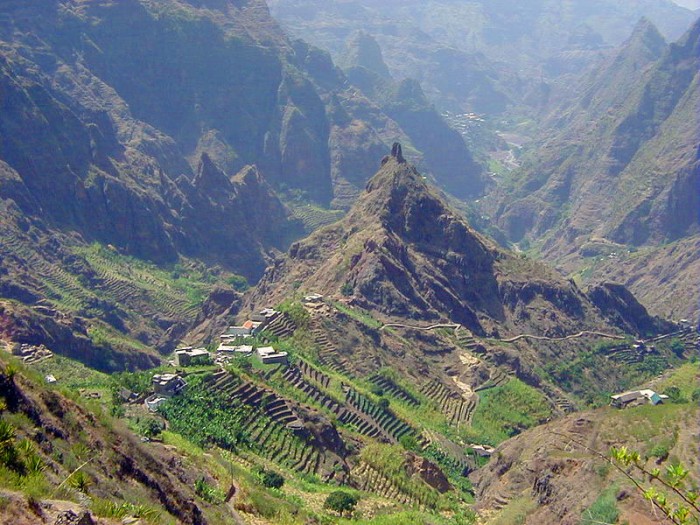
We departed from Anfi del Mar on the south coast of Grand Canary in gusty winds knowing that if we didn't depart now, we'd be socked in for another two weeks, as three low pressures revealed themselves big and mean in the weather forecasts. Winter has arrived. Time to get south.

After a day of bumpy sailing, the winds settled down into the NE and we had nice spinnaker runs for the next four days. The 6th day out the winds died and we drifted at 2knots until we received a weather GRIB announcing high winds from the impending low pressure, so we turned on the iron Genoa and motored along until reaching port at sunrise the 7th day out.
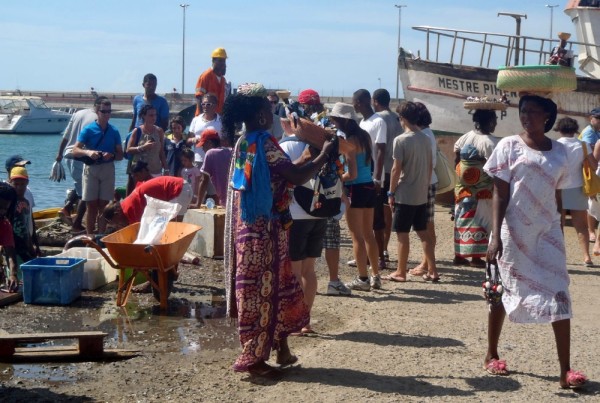
We dropped the hook in Madeira Bay in Palmeira on the island of Sal. The bottom was not good: sand and rock, the size of which were small boulders. A pair of buoys on our stern warned of doom if we dragged in the middle of the night. Being a crowded anchorage, we weighed anchor and commenced anchoring and dragging for the next two hours until we finally left the inner harbor and headed out into the open bay to anchor. The holding wasn't much better, but at least we got the hook in sand. Still a miniature city of boulders surrounded the boat.
By the 2nd day, the high winds came, bringing a nasty swell. In no time, a virtual mini-tsunami sized waves began to crash onto shore from the edge of stern. When the waves began to crash on our bow, we jumped into a Chinese Fire Drill to weight anchor and head out to sea.

In trying to weigh anchor, events worsened when Pete couldn't get the bridal untangled from the chain. If he didn't free it soon, we would surely be on the rocks. The Southern Cross was enduring the same drama next to us. After another very tense 3 minutes, I left he helm and was able to help Peter free the bridal. We roared the engines into life and launched out of the wild bay under dual engines at full speed. It was the most terrifying anchoring experience I'd ever endured in our thirty years of global cruising.

Five hours later, we dropped the hook in soft sand at the southern end of Sal (Santa Maria) and kissed the decks for a safe arrival. The decks were lifting and dropping from the high swell, but at least our anchor held. The Southern Cross limped over and we celebrated life with an Indian feast on Freebird.
The next five days we explored town, a cobbled stone village of African decent, formerly a Portuguese colony, now independent. Though a developing nation, the Cape Verdes is popular amongst adventurous backpackers. We looked for Lampa, an old friend of our son Warren, but his art gallery had been modified into a bar and boutique.
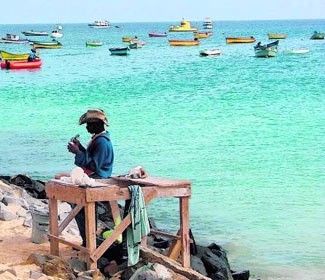
I loaded up on ebony hand-carved African artifacts to decorate our new boat, relishing the exchange of English with the gallery owners. They taught me about their island.
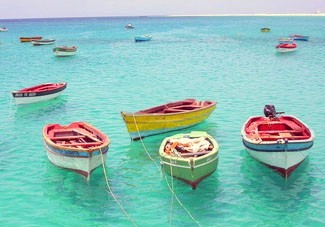
We swam in the turquoise clear waters and walked to the busy kite-boarding/windsurfing spot to take in the scene. Huge two meter waves slammed into shore, turning the screaming tourists into little tumbling balls of flesh on the steep shoreline. Peter grabbed the bougie board to hit the waves and rode one all the way in. My turn, he helped me over the swell and out to sea, then gave me a swift push into the next swell. I nearly cut my lolling tongue in half, as I screamed all the way down the swell into the beach where a line of tourists stood watching in horror and snapping photos with bullet propelled fingers. Snap, whirl. Snap, whirl. When I finally landed in a pile of sand, I looked at a dozen feet at my fingertips. The back-slop pulled me back into the swell, but I clung on for dear life onto their feet to keep from returning into those monstrous waves. "Wish I gotten your face on camera on that one!" Peter said later when I caught up with the gang of sailors standing post on the beach.
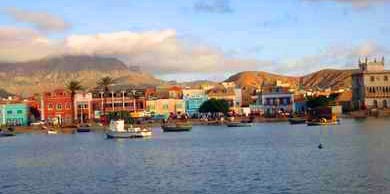
In Mindelo on St Vincent, we got water at the fisherman's dock, finished outfitting. Tomorrow we head out across the Atlantic Ocean. With us is our nephew Ian Ferris, our new crew member. Though a novice at sailing, he will be an excellent addition to our family of avid sailors.
After a day of bumpy sailing, the winds settled down into the NE and we had nice spinnaker runs for the next four days. The 6th day out the winds died and we drifted at 2knots until we received a weather GRIB announcing high winds from the impending low pressure, so we turned on the iron Genoa and motored along until reaching port at sunrise the 7th day out.

We dropped the hook in Madeira Bay in Palmeira on the island of Sal. The bottom was not good: sand and rock, the size of which were small boulders. A pair of buoys on our stern warned of doom if we dragged in the middle of the night. Being a crowded anchorage, we weighed anchor and commenced anchoring and dragging for the next two hours until we finally left the inner harbor and headed out into the open bay to anchor. The holding wasn't much better, but at least we got the hook in sand. Still a miniature city of boulders surrounded the boat.
By the 2nd day, the high winds came, bringing a nasty swell. In no time, a virtual mini-tsunami sized waves began to crash onto shore from the edge of stern. When the waves began to crash on our bow, we jumped into a Chinese Fire Drill to weight anchor and head out to sea.

In trying to weigh anchor, events worsened when Pete couldn't get the bridal untangled from the chain. If he didn't free it soon, we would surely be on the rocks. The Southern Cross was enduring the same drama next to us. After another very tense 3 minutes, I left he helm and was able to help Peter free the bridal. We roared the engines into life and launched out of the wild bay under dual engines at full speed. It was the most terrifying anchoring experience I'd ever endured in our thirty years of global cruising.
Five hours later, we dropped the hook in soft sand at the southern end of Sal (Santa Maria) and kissed the decks for a safe arrival. The decks were lifting and dropping from the high swell, but at least our anchor held. The Southern Cross limped over and we celebrated life with an Indian feast on Freebird.
The next five days we explored town, a cobbled stone village of African decent, formerly a Portuguese colony, now independent. Though a developing nation, the Cape Verdes is popular amongst adventurous backpackers. We looked for Lampa, an old friend of our son Warren, but his art gallery had been modified into a bar and boutique.

I loaded up on ebony hand-carved African artifacts to decorate our new boat, relishing the exchange of English with the gallery owners. They taught me about their island.

We swam in the turquoise clear waters and walked to the busy kite-boarding/windsurfing spot to take in the scene. Huge two meter waves slammed into shore, turning the screaming tourists into little tumbling balls of flesh on the steep shoreline. Peter grabbed the bougie board to hit the waves and rode one all the way in. My turn, he helped me over the swell and out to sea, then gave me a swift push into the next swell. I nearly cut my lolling tongue in half, as I screamed all the way down the swell into the beach where a line of tourists stood watching in horror and snapping photos with bullet propelled fingers. Snap, whirl. Snap, whirl. When I finally landed in a pile of sand, I looked at a dozen feet at my fingertips. The back-slop pulled me back into the swell, but I clung on for dear life onto their feet to keep from returning into those monstrous waves. "Wish I gotten your face on camera on that one!" Peter said later when I caught up with the gang of sailors standing post on the beach.

In Mindelo on St Vincent, we got water at the fisherman's dock, finished outfitting. Tomorrow we head out across the Atlantic Ocean. With us is our nephew Ian Ferris, our new crew member. Though a novice at sailing, he will be an excellent addition to our family of avid sailors.
Canary Islands
12 October 2012 | La Graciosa
Freebird
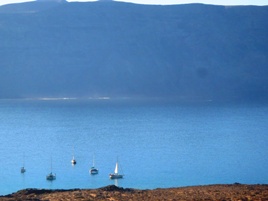
What other port in the world would only have sand for roads, and Safari Jeeps? It's Caleta del Sebo in La Graciosa of the Canary Island archipelago off the western coast of Africa. Adventure backpackers loved it here, and so did the sailors. We anchored in Isla La Graciosa for a few weeks while awaiting weather to sail to the Cape Verdes Islands, the next leg before making our transatlantic crossing.
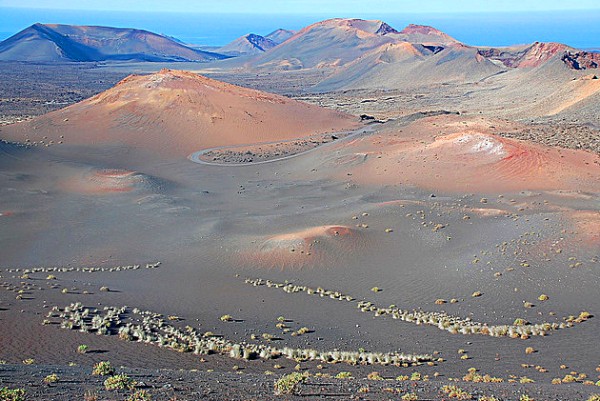
To get to the Spanish Canary Islands, we sailed from Morocco with "Cyan" and "Miss Jody" (both American vessels), "the Southern Cross" (Australian) and "Mischief" (French). There was no wind our first day out, which we knew would happen, but we were forced to go: either we departed now, or get stuck up the Moroccan river in Rabat for another two weeks due to an approaching low pressure. Though our time in Morocco was a tremendous experience, we needed to keep moving. Tropical storm "Nadine" had distracted us enough with her lingering hurricane force winds that wrecked havoc in the mid-Alantic. "Nadine" ended up being the longest running hurricane in history - more than 21 days.
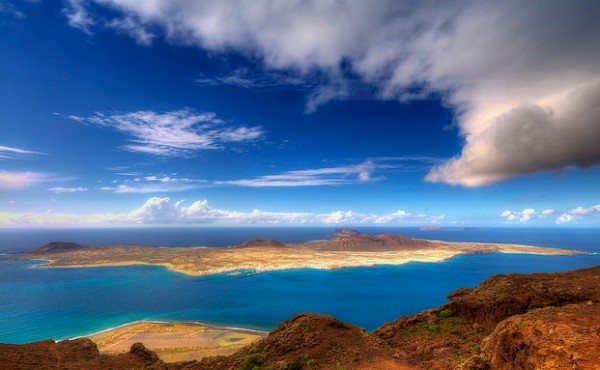
Once away from the coast of Africa on our passage to the Canary Islands, favorable winds filled in and "Freebird" took off like a train. Just as it looked we could make landfall before dusk, the wind gods stole our wind and we were forced to wallow offshore until daylight. During the night, we ran over a buoy attached to fishing nets. The buoy exploded to the surface, once Pete cast the line away from the rudder. But it's no fun sticking your head underwater with a knife in your mouth and a flashlight in your hand at night.
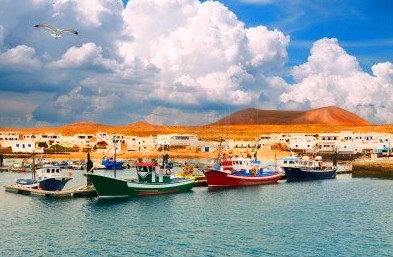
To rest up for our ocean passage, we decided to remain in La Graciosa. The Playa de la Francesa anchorage is the best in all of the Canaries - excellent holding, clean water for swimming, short hike to town, fuel, water and trash deposal available. Wifi at the local hamburger joint in town. Nationalities were represented from around the world: Swiss, Dutch, Norwegian, Swedish, Australian, German, French, Spain and Britain. For once, we were the minority here, as we were the only American vessel and the only cat amongst a fleet of monohulls. Everybody, it seemed, are headed around the world.
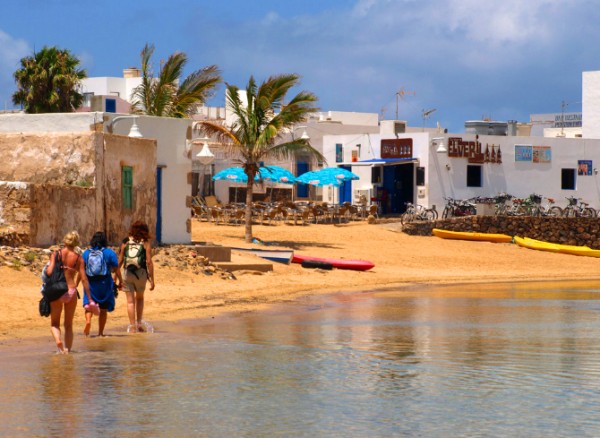
"You'll have a blast," I tell them. Maybe we should go around again?
In the meantime, we climbed the volcanic crater at the head of the anchorage, rambled into town to visit the Internet Cafe, and hiked into the countryside. Waters were clear and clean and we're on our way to the tropics!
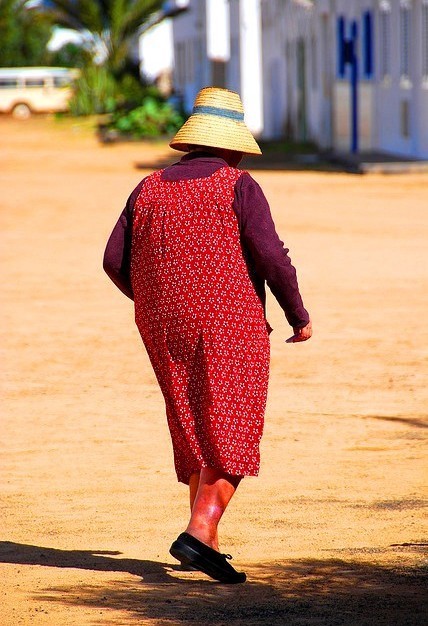

To get to the Spanish Canary Islands, we sailed from Morocco with "Cyan" and "Miss Jody" (both American vessels), "the Southern Cross" (Australian) and "Mischief" (French). There was no wind our first day out, which we knew would happen, but we were forced to go: either we departed now, or get stuck up the Moroccan river in Rabat for another two weeks due to an approaching low pressure. Though our time in Morocco was a tremendous experience, we needed to keep moving. Tropical storm "Nadine" had distracted us enough with her lingering hurricane force winds that wrecked havoc in the mid-Alantic. "Nadine" ended up being the longest running hurricane in history - more than 21 days.

Once away from the coast of Africa on our passage to the Canary Islands, favorable winds filled in and "Freebird" took off like a train. Just as it looked we could make landfall before dusk, the wind gods stole our wind and we were forced to wallow offshore until daylight. During the night, we ran over a buoy attached to fishing nets. The buoy exploded to the surface, once Pete cast the line away from the rudder. But it's no fun sticking your head underwater with a knife in your mouth and a flashlight in your hand at night.

To rest up for our ocean passage, we decided to remain in La Graciosa. The Playa de la Francesa anchorage is the best in all of the Canaries - excellent holding, clean water for swimming, short hike to town, fuel, water and trash deposal available. Wifi at the local hamburger joint in town. Nationalities were represented from around the world: Swiss, Dutch, Norwegian, Swedish, Australian, German, French, Spain and Britain. For once, we were the minority here, as we were the only American vessel and the only cat amongst a fleet of monohulls. Everybody, it seemed, are headed around the world.

"You'll have a blast," I tell them. Maybe we should go around again?
In the meantime, we climbed the volcanic crater at the head of the anchorage, rambled into town to visit the Internet Cafe, and hiked into the countryside. Waters were clear and clean and we're on our way to the tropics!

Morocco
14 September 2012 | Rabat & Casablanca
Freebird
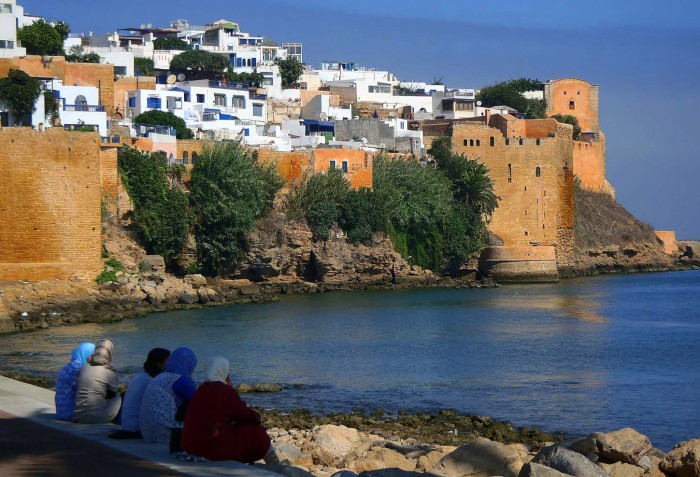
Our passage from Gibraltar to Morocco took longer than we had expected due to light winds. Grr... Miss Jody with Jo Anne & Ron and their crew/guests Sarah & Will arrived a full day into Rabat, Morocco before us. They stayed in close to shore; whereas we sailed 15-20 nm further offshore, hoping to avoid the plethora of fishing nets. Would you believe we started out with a gusty forecast!
Still, we snagged a fishing net. Fortunately, the orange float attached to it exploded to the surface from beneath our twin hulls, taking the net with it. And then we were free. Thank goodness Pete didn't have to go into the water at night to free our sail drives. Good thing our engines weren't running either, lest we foul the props. Pete has dove overboard to free the props - several times, in fact. Mostly, in daylight hours.
Dense fog encapsulated Freebird most of the night. We drifted in calm conditions until morning when the Rabat Marina skiff showed up to guide us over the shallow sandbar and up the Rio Sebou River to Rabat Marina. We never sat depths less than 15 feet. No worries there! We were told later that that very night, several thousand people lined the riverbanks, watching the jet ski race between 15 jet skis. We heard their sawing booms thundering across the harbor the following night.
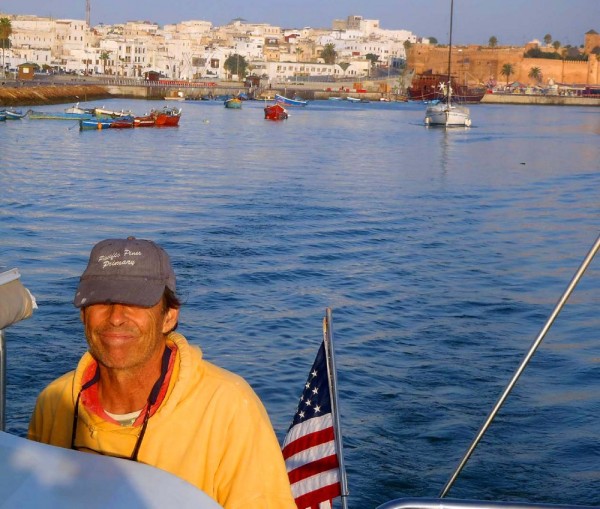
Rabat Marina is new and modern. Water and electricity was available at no charge. Rates off season are half-price (winter). 1 Moroccan dirham = 0.1176 US dollars, a very favorable exchange rate. We found the marina to be a good choice for leaving the boat for easy side trips via train, bus and tram around the country. One could stay three months and not see everything!
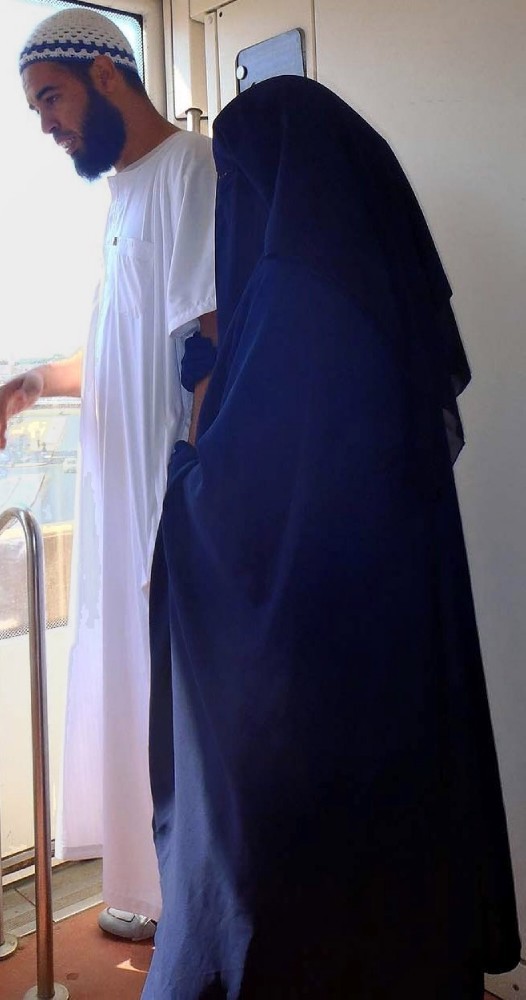
A quick walk to the modern tram took us across Rabat River to the center of Rabat. We entered the Souq through the main gate of the Medina. Inside the Medina, Morocco's very essence flashed by. The alleyways of the Medina are crowded quarters with winding lanes, dead ends, burlap bags piled high with ochre spices, mint tea drinkers in tiny chairs, and traders pining for our attention. It was a instant sensory assault around every corner and we relished it after the 1st world scene of the Mediterranean.
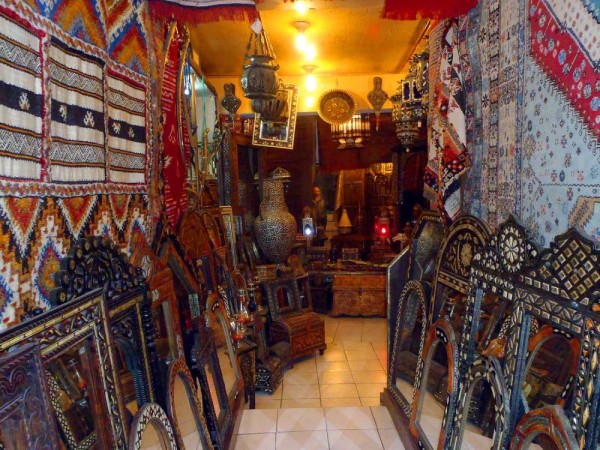
With Chuck and Lynn on Cyan we bartered for a tasseled Berber carpet, hand crafted in the Souq. We lunched on couscous and vegetable tajine.
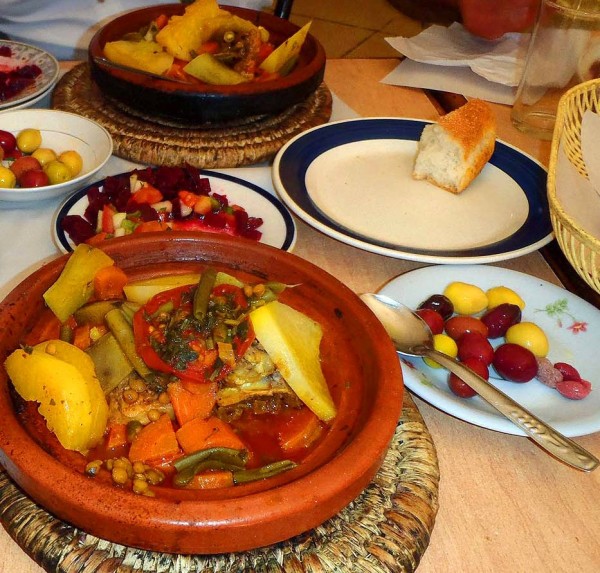
Next morning, we walked across the Rio Sebou River with Peter and Catherine from Southern Cross to trek through Rue des Consuls, one of the more interesting areas of the old Medina, crowded with craft shops and some of the grand diplomatic residencies. Before exiting, we came upon the carpet Souq lined with craft shops, which was once the setting for the slave auctions in earlier days. Muscled Africans hosted giant burlap sacks of rocks on their backs to cart through the Medina for road repairs. From there we made our way up the hill to the Kasbah, where berka clad women strolled along skinny blue-painted alleyways. The biggest challenge was paying attention to the waning batteries of our cameras after so many photos shot in quick succession from the stimulating scene.
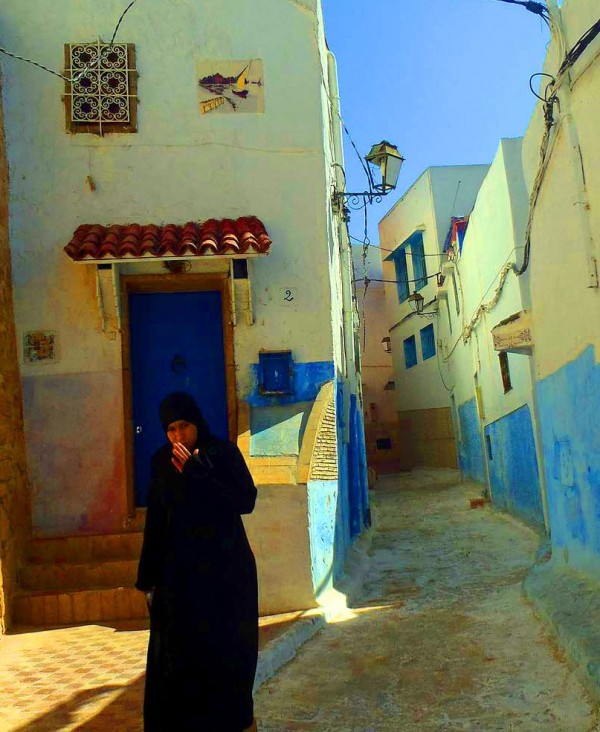
A group of us arose in the darkness of pre-dawn to make our way to the local train station for Casablanca. After a nearly 2 hour comfortable train ride, we were greeted at the Casablanca station by a taxi driver.
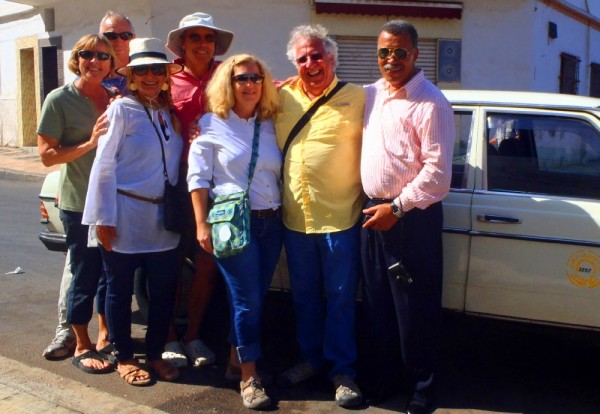
We hired him to drive us in his slick Mercedes aging - okay, dilapidated - limousine around the city center. He first took us to Rick's Café, named and modeled after the Hollywood flick, "Casablanca" with Humphrey Bogart and Ingrid Bergman, a love story during WWII. After quick group photo, we clambered back into the roomy limo to tour the enormous Hassan II Mosque. Located on the Casablanca scenic waterfront, it can accommodate up to 125,000 worshipers during Ramadan. The vast prayer hall is large enough to house Paris' Notre Dame or Rome's St Peter's. The 210m-high minaret, the grand mosque is the world's 3rd largest. We respectfully removed our shoes. A retractable roof of gold leaf, heated floor, and pool had us all goggle-eyed by the time we departed the granite confines.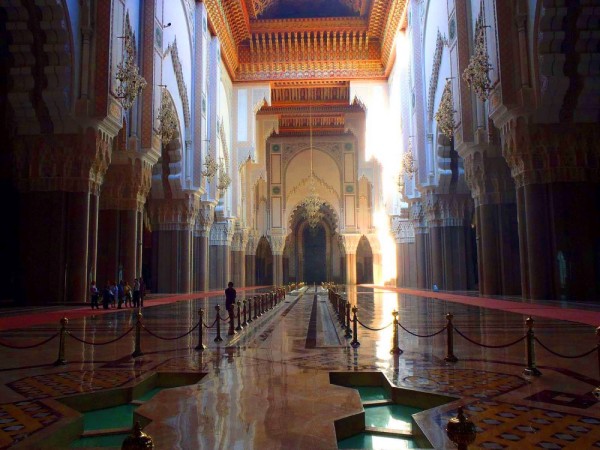
Still, we snagged a fishing net. Fortunately, the orange float attached to it exploded to the surface from beneath our twin hulls, taking the net with it. And then we were free. Thank goodness Pete didn't have to go into the water at night to free our sail drives. Good thing our engines weren't running either, lest we foul the props. Pete has dove overboard to free the props - several times, in fact. Mostly, in daylight hours.
Dense fog encapsulated Freebird most of the night. We drifted in calm conditions until morning when the Rabat Marina skiff showed up to guide us over the shallow sandbar and up the Rio Sebou River to Rabat Marina. We never sat depths less than 15 feet. No worries there! We were told later that that very night, several thousand people lined the riverbanks, watching the jet ski race between 15 jet skis. We heard their sawing booms thundering across the harbor the following night.

Rabat Marina is new and modern. Water and electricity was available at no charge. Rates off season are half-price (winter). 1 Moroccan dirham = 0.1176 US dollars, a very favorable exchange rate. We found the marina to be a good choice for leaving the boat for easy side trips via train, bus and tram around the country. One could stay three months and not see everything!

A quick walk to the modern tram took us across Rabat River to the center of Rabat. We entered the Souq through the main gate of the Medina. Inside the Medina, Morocco's very essence flashed by. The alleyways of the Medina are crowded quarters with winding lanes, dead ends, burlap bags piled high with ochre spices, mint tea drinkers in tiny chairs, and traders pining for our attention. It was a instant sensory assault around every corner and we relished it after the 1st world scene of the Mediterranean.

With Chuck and Lynn on Cyan we bartered for a tasseled Berber carpet, hand crafted in the Souq. We lunched on couscous and vegetable tajine.

Next morning, we walked across the Rio Sebou River with Peter and Catherine from Southern Cross to trek through Rue des Consuls, one of the more interesting areas of the old Medina, crowded with craft shops and some of the grand diplomatic residencies. Before exiting, we came upon the carpet Souq lined with craft shops, which was once the setting for the slave auctions in earlier days. Muscled Africans hosted giant burlap sacks of rocks on their backs to cart through the Medina for road repairs. From there we made our way up the hill to the Kasbah, where berka clad women strolled along skinny blue-painted alleyways. The biggest challenge was paying attention to the waning batteries of our cameras after so many photos shot in quick succession from the stimulating scene.

A group of us arose in the darkness of pre-dawn to make our way to the local train station for Casablanca. After a nearly 2 hour comfortable train ride, we were greeted at the Casablanca station by a taxi driver.

We hired him to drive us in his slick Mercedes aging - okay, dilapidated - limousine around the city center. He first took us to Rick's Café, named and modeled after the Hollywood flick, "Casablanca" with Humphrey Bogart and Ingrid Bergman, a love story during WWII. After quick group photo, we clambered back into the roomy limo to tour the enormous Hassan II Mosque. Located on the Casablanca scenic waterfront, it can accommodate up to 125,000 worshipers during Ramadan. The vast prayer hall is large enough to house Paris' Notre Dame or Rome's St Peter's. The 210m-high minaret, the grand mosque is the world's 3rd largest. We respectfully removed our shoes. A retractable roof of gold leaf, heated floor, and pool had us all goggle-eyed by the time we departed the granite confines.

Gibraltar
28 August 2012
Freebird
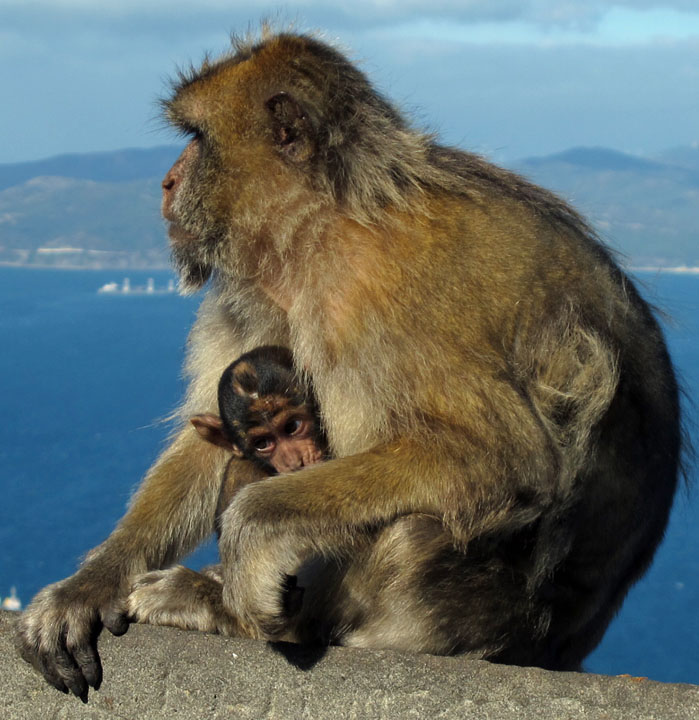
La Linea is a roomy anchorage with enough room for thirty boats. During the popular transit time of Aug/Sept we saw boats from a variety of countries. Most cruisers come here to avoid the heavy cost of a marina. The Yacht Club on the Spanish border offers secure tie-up, trash, water and wifi for 5 Euros/day. We used it whenever we needed to walk across the border from Spain to Gibraltar for duty-free shopping.
During our stay, we had two sails shipped from South Africa. We used Marina Bay in Gibraltar for the shipping address to avoid the extra cost of an agent/broker/delivery service. The day our sails were due (via tracking numbers) we took at slip at Marina Bay in Gibraltar for the day. To collect our sails, we walked the short distance to Customs at the airport to sign in the package. To avoid any surprise fees, we made sure YACHT IN TRANSIT was written on the outside of the box. After clearing in the package, we picked up our sails.
We offered a local 10 Euros to drive us back to the marina, instead of hunting down a taxi. The local kid acted as our personal guide while we were stuck at airport runway, waiting for a flight to land. Foot and vehicle traffic cross the runway too, and have to be halted early in order for flights to land.

Terrorists were allegedly planning to crash a light aircraft packed with explosives into families watching the Olympics on an outdoor screen and in bars. They apparently wanted to follow up the ruthless attack with a Mumbai-style machine-gun rampage on foot. Hardcore AL-Qaeda operatives are thought to have started pulling together a squad of fanatics late last year after deciding the London Games would be too well guarded.
The deranged gang is believed to have been inspired to plot an attack in the aftermath of the 10-year anniversary of 9/11 and debated a number of possible ways to kill Britons outside the UK. They settled on an assault on a soft target of UK citizens and their families based in Gibraltar while they were watching the Games out in the open.
Say what? Yahoo MI-6! Go guys!
We found the amazing Farmers' Market on the Spanish border in La Linea. Everyday, a 1-mile long area in the town center near the English Plaza is crowded with vendors selling everything imaginable - perfect for us! Much of it was blocked off from vehicular traffic. Every week we loaded up our push carts and had café con leche in the Plaza Square while watching the sweet families stroll by in their fashionable get-ups.
We acted like the tourists we are in Gibraltar, taking in all the sites. The museum was very interesting. A 15minute documentary on the history was the country was especially nice. We bought a Kindle, new phone and other goodies on Main Street in Gibraltar with the Duty Free products.
Cigarette smuggling from Gibraltar to Spain has kept us entertained at sundown, especially after the fog rolled in. Go fast boats jetted out into the harbor behind our anchorage to rush over to Gibraltar. There, the smugglers picked up a boat load of cigarettes and then jetted back over to the Spanish border. Two hundred cigs earn one man 4 Euro profit. Since 80% of the youth are unemployed in La Linea, this is the main way of quick funds for them. All the cig kiosks were packed with buyers whenever we passed by.
During our stay, we had two sails shipped from South Africa. We used Marina Bay in Gibraltar for the shipping address to avoid the extra cost of an agent/broker/delivery service. The day our sails were due (via tracking numbers) we took at slip at Marina Bay in Gibraltar for the day. To collect our sails, we walked the short distance to Customs at the airport to sign in the package. To avoid any surprise fees, we made sure YACHT IN TRANSIT was written on the outside of the box. After clearing in the package, we picked up our sails.
We offered a local 10 Euros to drive us back to the marina, instead of hunting down a taxi. The local kid acted as our personal guide while we were stuck at airport runway, waiting for a flight to land. Foot and vehicle traffic cross the runway too, and have to be halted early in order for flights to land.
Terrorists were allegedly planning to crash a light aircraft packed with explosives into families watching the Olympics on an outdoor screen and in bars. They apparently wanted to follow up the ruthless attack with a Mumbai-style machine-gun rampage on foot. Hardcore AL-Qaeda operatives are thought to have started pulling together a squad of fanatics late last year after deciding the London Games would be too well guarded.
The deranged gang is believed to have been inspired to plot an attack in the aftermath of the 10-year anniversary of 9/11 and debated a number of possible ways to kill Britons outside the UK. They settled on an assault on a soft target of UK citizens and their families based in Gibraltar while they were watching the Games out in the open.
Say what? Yahoo MI-6! Go guys!
We found the amazing Farmers' Market on the Spanish border in La Linea. Everyday, a 1-mile long area in the town center near the English Plaza is crowded with vendors selling everything imaginable - perfect for us! Much of it was blocked off from vehicular traffic. Every week we loaded up our push carts and had café con leche in the Plaza Square while watching the sweet families stroll by in their fashionable get-ups.
We acted like the tourists we are in Gibraltar, taking in all the sites. The museum was very interesting. A 15minute documentary on the history was the country was especially nice. We bought a Kindle, new phone and other goodies on Main Street in Gibraltar with the Duty Free products.
Cigarette smuggling from Gibraltar to Spain has kept us entertained at sundown, especially after the fog rolled in. Go fast boats jetted out into the harbor behind our anchorage to rush over to Gibraltar. There, the smugglers picked up a boat load of cigarettes and then jetted back over to the Spanish border. Two hundred cigs earn one man 4 Euro profit. Since 80% of the youth are unemployed in La Linea, this is the main way of quick funds for them. All the cig kiosks were packed with buyers whenever we passed by.
Spain
06 August 2012 | 36 09.38N
Freebird
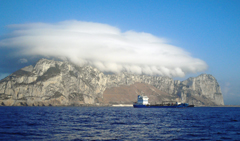
SPAIN
Caleta del Estacio, Mar Menor: 037.44.36N/00.44.04E
We raced under spinnaker to the 'inland lake" of Mar Menor (a short run of 127 nm), located on the Spanish mainland. We challenged "The Southern Cross" to the match. Videos were made, photos taken. Together we both arrived at sun-up the following day. In the Med, winds were either too strong or too light, so at times, we were forced to drift along at 3-4 knots beneath a 7knot breeze. "Cranking up the 'iron jenny' just wasn't any option," said my sweet Captain Bligh.

We were pleased to see the anchorage as totally protected. Mistrals were still arriving every 1-2 weeks, and some of our friends were emailing reports of having sustained yacht damage while caught underway. Inside the Mar Menor anchorage (outside the inland lake), calm waters were unfiltered from natural sea currents, and were enclosed by steel barriers, remnants of former marina construction having gone sour due to the recession. Basketball sized neon-blue jellyfish made their home beneath our boat, and smaller ones cluttered the edge of the beach behind us. Still, Pete and I swam amongst them, desperate to swim and cool off in the heat. Swimming was like drifting through space and navigating through an obstacle course of giant jelly beans. At least they didn't sting, although that was arguable.

To lighten our hearts and check items off the 'to-do' list, we took the local bus into Cartagena, a historical city with an ancient village wall. We strolled through skinny alleyways during siesta time - when crowds were thin - to gape at Roman Ruins: a Coliseum, the Old Teatro, and the Forum. No matter how many times we saw Roman Ruins, it always took our breaths away.
A British yachting couple, who resided nearby, brought us up-to--date on the economic hardships facing Spain: 40% unemployment, family splits (daughter took the children home to her parents, the father was left to fend with his parents), abandoned apartment buildings, abandoned construction, empty cafes, and on and on. Most nights behind our boat, the unemployed and desperate met to fish, drink, and belt out songs of the forlorn. They never caught a fish and returned the next day to repeat their performance. It was sad. I couldn't wait to leave, weary and fatigued from sleep deprivation. Our friends on "Southern Cross" and "Scotia" departed too, all of us in the wake of "Cyan".
La Linea de la Conceptcion: 036 09.38N/005 21.027E

We anchored near the light tower, just a stone's throw from Gibraltar. Several yachts used this anchorage to make repairs and outfit out of Gibraltar and to stage for a Canary crossing. There was plenty of room for the dozen sailboats anchored there and a long beach to walk Bella.
Caleta del Estacio, Mar Menor: 037.44.36N/00.44.04E
We raced under spinnaker to the 'inland lake" of Mar Menor (a short run of 127 nm), located on the Spanish mainland. We challenged "The Southern Cross" to the match. Videos were made, photos taken. Together we both arrived at sun-up the following day. In the Med, winds were either too strong or too light, so at times, we were forced to drift along at 3-4 knots beneath a 7knot breeze. "Cranking up the 'iron jenny' just wasn't any option," said my sweet Captain Bligh.

We were pleased to see the anchorage as totally protected. Mistrals were still arriving every 1-2 weeks, and some of our friends were emailing reports of having sustained yacht damage while caught underway. Inside the Mar Menor anchorage (outside the inland lake), calm waters were unfiltered from natural sea currents, and were enclosed by steel barriers, remnants of former marina construction having gone sour due to the recession. Basketball sized neon-blue jellyfish made their home beneath our boat, and smaller ones cluttered the edge of the beach behind us. Still, Pete and I swam amongst them, desperate to swim and cool off in the heat. Swimming was like drifting through space and navigating through an obstacle course of giant jelly beans. At least they didn't sting, although that was arguable.

To lighten our hearts and check items off the 'to-do' list, we took the local bus into Cartagena, a historical city with an ancient village wall. We strolled through skinny alleyways during siesta time - when crowds were thin - to gape at Roman Ruins: a Coliseum, the Old Teatro, and the Forum. No matter how many times we saw Roman Ruins, it always took our breaths away.
A British yachting couple, who resided nearby, brought us up-to--date on the economic hardships facing Spain: 40% unemployment, family splits (daughter took the children home to her parents, the father was left to fend with his parents), abandoned apartment buildings, abandoned construction, empty cafes, and on and on. Most nights behind our boat, the unemployed and desperate met to fish, drink, and belt out songs of the forlorn. They never caught a fish and returned the next day to repeat their performance. It was sad. I couldn't wait to leave, weary and fatigued from sleep deprivation. Our friends on "Southern Cross" and "Scotia" departed too, all of us in the wake of "Cyan".
La Linea de la Conceptcion: 036 09.38N/005 21.027E

We anchored near the light tower, just a stone's throw from Gibraltar. Several yachts used this anchorage to make repairs and outfit out of Gibraltar and to stage for a Canary crossing. There was plenty of room for the dozen sailboats anchored there and a long beach to walk Bella.
| Vessel Name: | Freebird |
| Vessel Make/Model: | Grainger 42' Performance Catamaran |
| Hailing Port: | St Thomas, US Virgin Islands |
| Crew: | Capt Peter and Tina Dreffin |
| About: | |
| Extra: | www.BahamasCatCharters.com www.FreebirdSailingAdventures.com |
| Home Page: | http://www.freebirdsailingadventures.com |
Gallery not available
BAHAMAS: Going Native
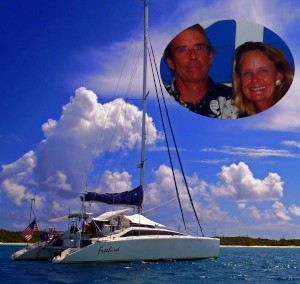
Who: Capt Peter and Tina Dreffin
Port: St Thomas, US Virgin Islands
No Links Added Yet